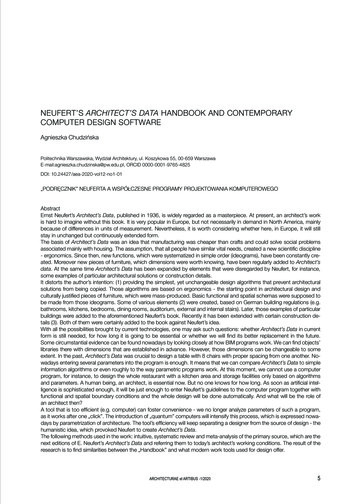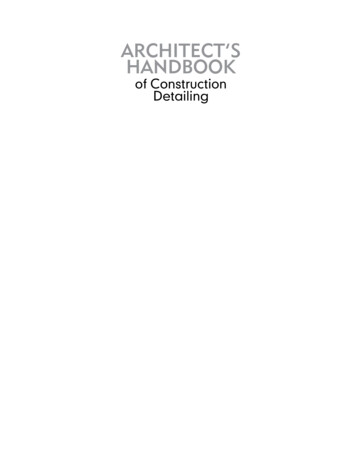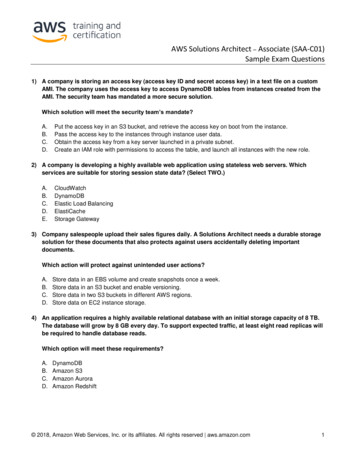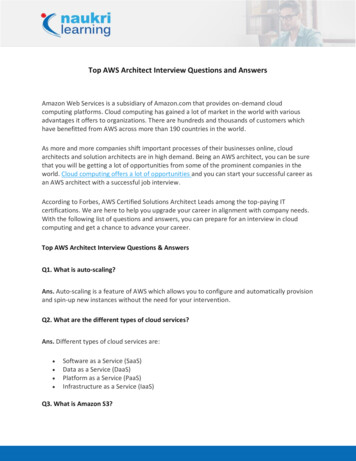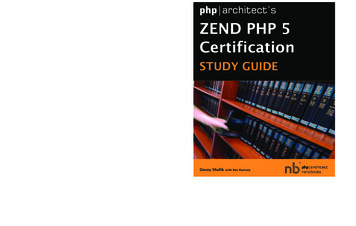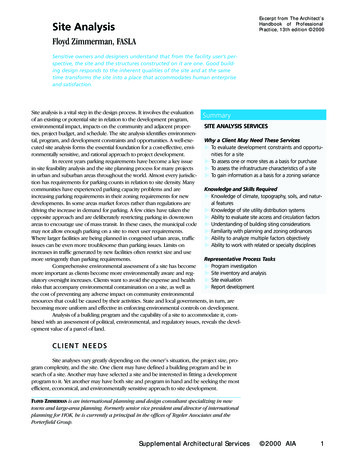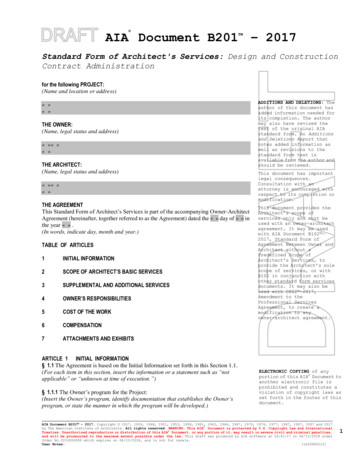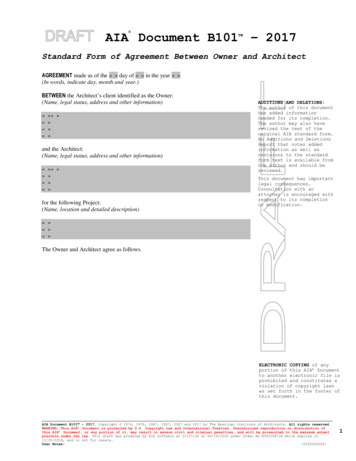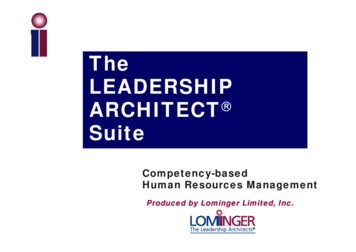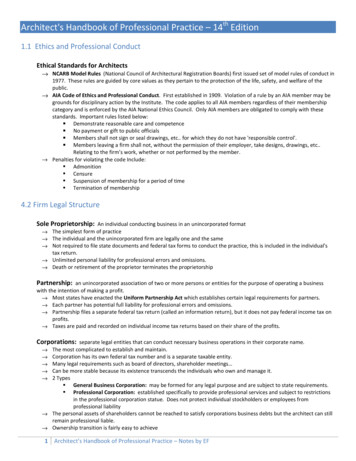
Transcription
Architect's Handbook of Professional Practice – 14th Edition1.1 Ethics and Professional ConductEthical Standards for Architects NCARB Model Rules (National Council of Architectural Registration Boards) first issued set of model rules of conduct in1977. These rules are guided by core values as they pertain to the protection of the life, safety, and welfare of thepublic. AIA Code of Ethics and Professional Conduct. First established in 1909. Violation of a rule by an AIA member may begrounds for disciplinary action by the Institute. The code applies to all AIA members regardless of their membershipcategory and is enforced by the AIA National Ethics Council. Only AIA members are obligated to comply with thesestandards. Important rules listed below: Demonstrate reasonable care and competence No payment or gift to public officials Members shall not sign or seal drawings, etc. for which they do not have 'responsible control'. Members leaving a firm shall not, without the permission of their employer, take designs, drawings, etc.Relating to the firm's work, whether or not performed by the member. Penalties for violating the code Include: Admonition Censure Suspension of membership for a period of time Termination of membership4.2 Firm Legal StructureSole Proprietorship: An individual conducting business in an unincorporated format The simplest form of practice The individual and the unincorporated firm are legally one and the same Not required to file state documents and federal tax forms to conduct the practice, this is included in the individual'stax return. Unlimited personal liability for professional errors and omissions. Death or retirement of the proprietor terminates the proprietorshipPartnership: an unincorporated association of two or more persons or entities for the purpose of operating a businesswith the intention of making a profit. Most states have enacted the Uniform Partnership Act which establishes certain legal requirements for partners. Each partner has potential full liability for professional errors and omissions. Partnership files a separate federal tax return (called an information return), but it does not pay federal income tax onprofits. Taxes are paid and recorded on individual income tax returns based on their share of the profits.Corporations: separate legal entities that can conduct necessary business operations in their corporate name.The most complicated to establish and maintain.Corporation has its own federal tax number and is a separate taxable entity.Many legal requirements such as board of directors, shareholder meetings Can be more stable because its existence transcends the individuals who own and manage it.2 Types General Business Corporation: may be formed for any legal purpose and are subject to state requirements. Professional Corporation: established specifically to provide professional services and subject to restrictionsin the professional corporation statue. Does not protect individual stockholders or employees fromprofessional liability The personal assets of shareholders cannot be reached to satisfy corporations business debts but the architect can stillremain professional liable. Ownership transition is fairly easy to achieve 1 Architect’s Handbook of Professional Practice – Notes by EF
Buy/Sell Agreement: the usual method for compensating departing shareholders. Subchapter 'S' Corporation: shareholders are taxed on their pro rata share of the corporation's income.Limited Liability Companies (LLC): complex hybrids of corporations and partnerships. Classified as a partnership for federal tax purposes Owners of LLC are called Members and they have limited personal liability.9.4 Dispute Resolution MethodsArbitration Preferred method of dispute resolution. AIA was one of the founding members of the American Arbitration Association (AAA) in 1926. Benefits of Arbitration: Dispute is resolved by an arbitrator who is knowledgeable in the construction industry, not a judge or jury whomay know nothing about construction. Fee proportionate to amount of claim. (Administrative feeds are high but trial fees lower than litigation) Disputes can be resolved in weeks or months, rather than years for litigation. Certain amount of privacy in the resolution, compared to very public trials. Arbitration Process: One party files a "demand for arbitration" The other party then has 3 options1. File answer in response to allegations2. File a counterclaim3. Do nothing and the AAA will consider the demand to have been denied. AAA appoints case administrator and sends a list of prospective arbitrators with extensive constructionindustry experience. One or both parties can object to a particular arbitrator with good reason. Pre-hearing conference to discuss schedule and process between both parties for upcoming arbitration. Hearing is held and follows a court-proceeding type format Arbitrator will "close the record" and render a decision within 30 days. There are very narrow, if any grounds for turning over an arbitrator's decision 3 Different Arbitration Procedures: Fast-Track Procedures: For cases involving 75,000 or less, only 1 arbitrator is selected and hearing is heldwithin a short period of time. The entire process is completed fairly quickly, within a few months. Standard Track: For cases between 75,000 and 1 million. 1-3 arbitrators are selected, hearing held 6-9months from the prehearing conference. Large Case Track: Involves multi-million dollar disputes. Discovery is permitted and time period is even longerMediationEmerged within the last 10 years as an alternative to arbitration.Mediation must be agreed upon by both parties and is also administered by the AAA.The Mediator assists the parties in settling the dispute to avoid court or arbitration.Benefits of Mediation: Mediation session is very quick, typically taking only a single day. Allows relationships to be maintained. Privacy; there is no discovery or hearing Filing fees are very minimal Mediation Process: One party files a "demand for mediation" Parties agree upon the selection of a mediator or the AAA appoints a mediator. Mediator holds a pre-mediation telephone conference and schedules date for mediation (usually within 60days of conference) Within this time parties may submit information to mediator to educate him/her about the dispute, thisinformation can be submitted confidentially without knowledge of the other party. At Mediation session, parties exchange positions and mediator separates parties into different rooms to begin"shuttle diplomacy" during which offers are exchanged and counteroffers considered. Parties must decide whether to accept or reject solutions suggested by the mediator. 2 Architect’s Handbook of Professional Practice – Notes by EF
Once an agreement is reached, a written settlement agreement is drafted. If an agreement is not reached,parties may proceed to an alternate method of binding dispute resolution.Dispute Review Board Very similar to arbitration except that the dispute review board is generally appointed at the beginning of the projectbefore an disputes arise. Pros: The board is already familiar with the project, therefore, a decision can be reached quickly. Cons: High cost associated with involving these individuals from project onset; only practical on the most expensiveconstruction projects.11.1 Defining Project ServicesBasic vs. Additional Services According to B101-2007, Standard Form of Agreement Between Owner and Architect: Basic Services:o Schematic Design thru Construction Phaseo Preliminary evaluation of the owner's program, schedule, budget, site, and proposed method of projectdelivery.o Providing an estimate for the cost of work beginning with SD and continuing through CDso Assisting the owner in analyzing the bid results.o Includes making inspections for substantial and final completiono Includes site visits at "intervals appropriate to the stage of construction"o Reviewing RFIs and Payment Applications Additional Services (added to contract at signing):o Site Evaluation & Planningo Historic Preservationo Commissioningo LEED Certificationo Architectural Interior Designo Furniture, Furnishings, and Equipment Design Additional Services (become necessary during the course of project added later):o Revisions due to enactment of new codes, laws, or regulationso Revisions caused by changes in initial information from owner or non-timely decisionso Preparation for and attendance at public hearings or dispute resolution proceedingso Evaluation of substitutionso Preparing drawings for alternate bid or proposal requestso Assisting the owner in determining the qualifications of specific bidders 2007 Series AIA Owner-Architect Agreements B102-2007, Agreement between Owner and Architect without a Predefined Scope of Architect's Services B103-2007, Agreement between Owner and Architect for a Large of Complex Project B104-2007, Agreement between Owner and Architect for a Project of Limited Scope B105-2007, Agreement between Owner and Architect for a Residential or Small Commercial Project. B201-2007, Scope of Services: Design and Construction Contract Administration. Never proceed with services that are considered "additional" without first requesting and receiving owner approval forfurther compensation.11.2 Architectural Services and CompensationRisk Assessment and Pricing Consider the following potential risks when drafting architectural services proposals: Process of client decision making and approvals; who will be making the decisions and in what amount of timewill a decision be reached Potential for scope changes Will there be involvement from a third-party project manager? This can complicate the process. Fast-track and construction-driven delivery schedules are most costly and difficult to coordinate.3 Architect’s Handbook of Professional Practice – Notes by EF
If construction estimates will be provided by a third party risk increases. Architect should retain parallelestimating capability and include budget contingencies for uncertainties.Make sure the owner understands the standard of care for design and technical coordination that they don'texpect perfect construction documents and are willing to pay for additional costs due to normal coordinationissues.Confirm client's financial resources and ability to pay.Compensation Options Fixed (Stipulated Sum) Fees: A firm compensation amount related to a particular scope of services. Appropriate when services can be precisely defined Offer the greatest profit potential to the firm. To avoid risk of cost exceeding fixed fee budget, a contingency amount should be included. Hourly Billing Rates and Fee Multipliers: The most flexible fee option for architects and clients Preferred when no exact scope of services can be defined. Often used for the preliminary phases and later converted to fixed fees. Limited profit potential because of planned profit percentage. Avoid Fixed fee with hourly cap, this is a no-win option. Fixed dollar rates (e.g. 125 per hour) to cover direct salary cost, fringe benefits, overhead & profit. Rates canbe structured by staff position, allowing further flexibility. Fee Multipliers:o Multiple of Direct Salary Expense (DSE): salary expense is multiplied by a factor that covers fringebenefits, overhead, & profit.o Multiple of Direct Personnel Expense (DPE): staff fringe benefits are part of the DPE base and notthe multiplier. Cost plus Fixed Fee: An hourly fee option in which a client is billed for the actual cost of an architect's effort (base salaries, fringebenefits, and firm overhead) on a rate or multiplier basis, and a fixed fee is negotiated as the firm's profit. Limit profit potential but greatly reduce risk of losses Desirable for client because they avoid substantial contingencies in a fixed-fee proposal due to unknowns. Unit Cost Methods: Price based on cost per square foot, room, store, building, or other unit. Often used for office planning, interior design, and hotels. Requires accurate and timely data for cost. Percentage of Construction Cost: Ties the architect's compensation to the budgeted or actual construction cost of a project. This method isinfrequently used. Assumes that construction cost is directly proportional to the architect's effort (often false) Penalize architect's for their efforts to reduce construction cost. Could give client impression that architect intentionally would drive up cost of construction to increase fee. Can create an adversarial relationship between client and architect. Often converted to a fixed-fee structure once scope and budget are confirmed (CD phase) Outcome-Based Value Pricing: Architect can tie their compensation to revenue, cost, or profitability results achieved by the proposedproject. Examples: sales in retail facilities, leasing success in housing or commercial office development. Reimbursable and Non-reimbursable Direct Costs: Consider other direct costs that are related to the work, but not covered in the firm's overhead structure. Includes travel, mail and courier services, printing, photography, materials, or equipment.11.4 Project Delivery Methods4 Architect’s Handbook of Professional Practice – Notes by EF
Key Players Owner: Can be an individual, organization, or other entity The eventual owner or operator of the finished facifacilitylity who is responsible for paying the cost of constructing thebuilding. Architect: Designs,esigns, documents, and typically administers the contract(s) for construction of the project. Contractor: Responsibleesponsible for the actual construction of the project. Teameam may include subcontractors, suppliers, and fabricafabricators.Key Factors Affecting Delivery Choice An increase in one parameter below implies a change to another Construction CostSchedule; critical when interest rates are ver
AIA Code of Ethics and Professional Conduct. First established in 1909. Violation of a rule by an AIA member may be grounds for disciplinary action by the Institute. The code applies to all AIA members regardless of their membership category and is enforced by the AIA National Ethics Council. Only AIA members are obligated to comply with these standards. Important rules listed below .

